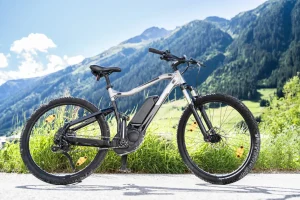Gravel biking, a niche within the cycling world, has gained remarkable popularity in recent years. Defined by its versatility, gravel bikes offer riders a unique experience, allowing them to conquer a variety of terrains with ease.

Key Features of Gravel Bikes
Here are some of the key features of gravel bikes:
- Drop handlebars: Most gravel bikes have drop handlebars, which provide multiple hand positions for comfort and control on different terrains.
- Wider tires: Gravel bikes have wider tires than road bikes, typically 35mm or more in width. This provides better traction and comfort on rough surfaces.
- Disc brakes: Disc brakes are standard on gravel bikes, as they provide more powerful and consistent stopping power than rim brakes, especially in wet or muddy conditions.
- Slacker geometry: Gravel bikes have a slacker geometry than road bikes, which means the head tube is higher and the handlebars are farther in front of the rider. This provides a more comfortable and upright riding position, which is better for off-road riding.
- More mounting points: Gravel bikes often have more mounting points than road bikes, so you can attach fenders, racks, and other accessories for bikepacking or commuting.
These are just some of the key features of gravel bikes. If you are looking for a versatile and comfortable bike that can handle a variety of terrain, then a gravel bike is a great option.
Components and Technology|Gravel Biking
Advanced gear systems, diverse suspension options, and innovative frame materials contribute to the technological marvel that is the gravel bike. These components are carefully engineered to enhance the rider’s experience, ensuring optimal performance in every situation.
Choosing the Right Gravel Bike
Selecting the perfect gravel bike involves considering personal preferences, sizing, and budget constraints. With various options available, riders can find a bike that caters to their specific needs, ensuring a comfortable and enjoyable riding experience.

Maintenance Tips
To prolong the life of a gravel bike, regular maintenance is essential. From cleaning after off-road rides to routine check-ups on components, proper care ensures the bike remains in peak condition.
Gravel Biking Culture
The gravel biking community is rapidly growing, with enthusiasts participating in events and sharing their experiences on social media. The culture surrounding gravel biking fosters a sense of camaraderie and adventure.
Benefits of Gravel Biking
Apart from the physical health benefits, gravel biking offers mental well-being and stress relief. The thrill of exploration and adventure adds a unique dimension to this form of cycling.
Challenges and Solutions
Gravel biking presents challenges, such as navigating rough terrains and addressing maintenance issues. However, these challenges contribute to the development of rider skills and a deeper connection with the sport.
Popular Gravel Biking Routes
Scenic locations around the world become playgrounds for gravel bikers. From picturesque countryside routes to challenging mountain trails, gravel bikers have a plethora of options to explore.
Gravel Biking Accessories
Essential gear and technological accessories enhance the gravel biking experience. From specially designed clothing to navigation gadgets, these accessories contribute to a smoother and more enjoyable ride.
Comparisons with Other Bike Types
Gravel bikes have carved out a unique niche in the cycling world, offering the versatility to tackle paved roads, dirt paths, and even light singletrack. But how do they stack up against other popular bike types? Let’s delve into the key comparisons:
Road Bikes:
Similarities:
- Drop handlebars: Both feature drop bars for multiple hand positions and efficient road riding.
- Lightweight: Both prioritize speed and efficiency, often using similar lightweight materials.
Differences:
- Tire width: Gravel bikes have much wider tires (35mm+) for grip and comfort on rough terrain, while road bikes have narrower tires (23-28mm) for speed and aerodynamics on smooth surfaces.
- Geometry: Gravel bikes have a slacker geometry with a higher head tube and longer chainstays for stability and comfort on uneven terrain. Road bikes have a more aggressive geometry for a lower, aerodynamic position on pavement.
- Brakes: Disc brakes are standard on gravel bikes for all-weather stopping power, while rim brakes are still common on road bikes for weight savings (though disc brakes are gaining popularity).
- Mounting points: Gravel bikes often have more mounting points for racks, fenders, and bags for bikepacking or commuting, while road bikes typically have minimal mounts.
Verdict: Gravel bikes are the more versatile choice, handling both paved and unpaved roads with comfort. Road bikes excel on smooth tarmac, prioritizing speed and efficiency.
Mountain Bikes:
Similarities:
- Wider tires: Both have wider tires for grip and comfort on rough terrain.
- Disc brakes: Disc brakes are standard on both for powerful stopping in all conditions.
Differences:
- Handlebars: Gravel bikes use drop bars for multiple hand positions and road riding, while mountain bikes primarily use flat handlebars for better control on technical terrain.
- Suspension: Gravel bikes have no suspension, relying on tire width and frame flex for comfort. Mountain bikes often have front suspension or full suspension for tackling more challenging terrain.
- Drivetrain: Gravel bikes typically have simpler drivetrains with fewer gears for efficient pedaling on varied terrain. Mountain bikes often have wider gear ranges for climbing steep hills and technical features.
Verdict: Gravel bikes are ideal for smooth dirt paths and light singletrack, while mountain bikes are better suited for technical terrain with rocks, roots, and drops.
Hybrid Bikes:
Similarities:
- Upright riding position: Both offer a comfortable, upright riding position for leisure riding and commuting.
- Wider tires: Both have wider tires than road bikes for comfort on rough roads and paths.
Differences:
- Drop handlebars: Gravel bikes have drop bars for more hand positions and efficient road riding, while hybrid bikes typically have flat handlebars for relaxed cruising.
- Frame material: Gravel bikes often use lightweight materials like aluminum or carbon fiber for performance, while hybrid bikes prioritize comfort and affordability with heavier materials like steel.
- Tire width: Gravel bikes usually have wider tires for more off-road capability, while hybrid bikes have tires closer to road bikes for paved surfaces.
Verdict: Hybrid bikes are great for casual rides and commuting on mixed terrain, while gravel bikes offer more performance and wider range for exploring beyond paved roads.
Ultimately, the best bike for you depends on your riding style and intended use. Gravel bikes offer a compelling blend of versatility, comfort, and performance, making them a popular choice for adventurous riders who crave variety in their cycling experiences.

Inspirational Gravel Biking Stories
Personal narratives of riders overcoming challenges and achieving milestones inspire others to take up gravel biking. These stories showcase the transformative power of the sport.
Environmental Impact
Gravel biking embraces sustainable practices, and many events prioritize eco-friendly initiatives. The community is increasingly conscious of its environmental impact, fostering a commitment to responsible riding.
Future Trends in Gravel Biking
As technology advances, gravel biking is likely to witness innovations in design and materials. Anticipated changes will further enhance the performance and appeal of gravel bikes.
Conclusion
In conclusion, gravel biking offers a thrilling and adventurous experience for cyclists. With its growing popularity, diverse community, and the continuous evolution of technology, gravel biking is set to remain a prominent aspect of the cycling world.
FAQs
Is gravel biking suitable for beginners?
Gravel biking can be adapted to different skill levels, making it accessible for beginners with proper guidance.
Do gravel bikes require special maintenance compared to other types?
While gravel bikes do have specific maintenance needs, they are not significantly different from other types of bikes.
What makes gravel biking environmentally friendly?
Gravel biking events often promote sustainability, and the sport itself encourages responsible riding practices.
Can I use a gravel bike for everyday commuting?
Gravel bikes are versatile and can be used for commuting, providing a comfortable and efficient ride on various surfaces.
Are there specific safety measures for gravel biking?
Safety is paramount in gravel biking. Wearing appropriate protective gear and adhering to trail regulations ensure a secure riding experience.













